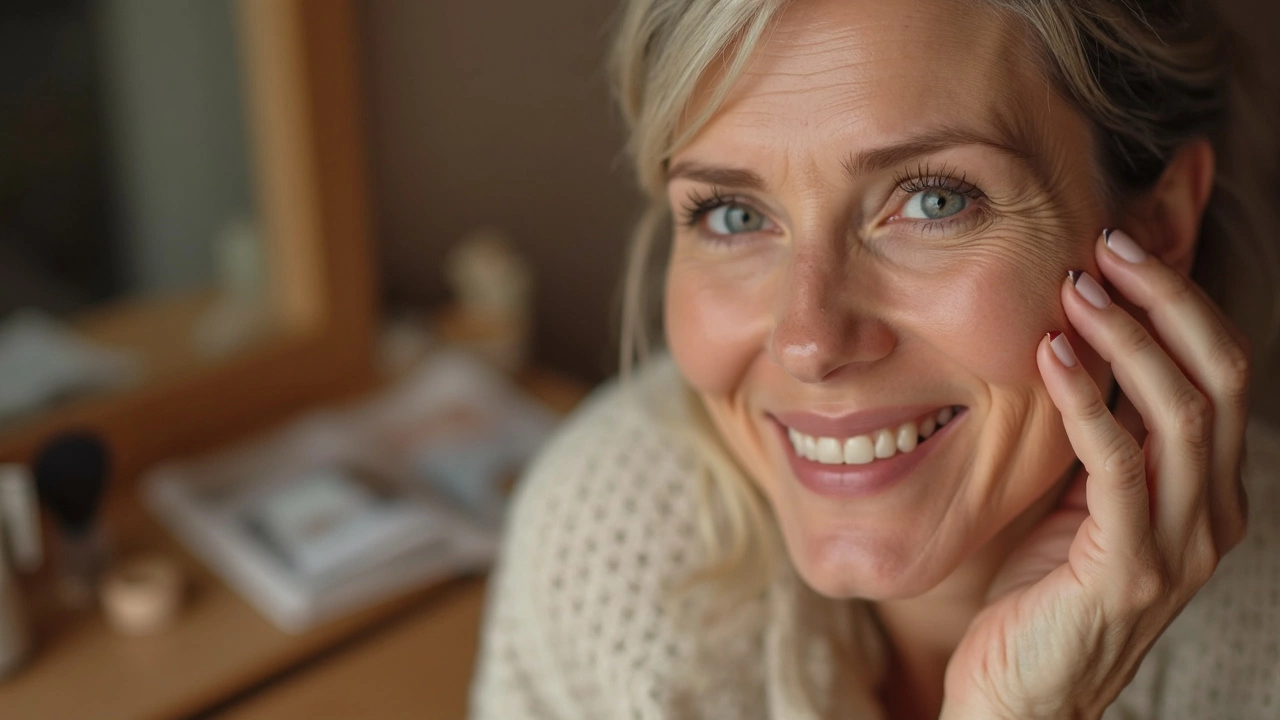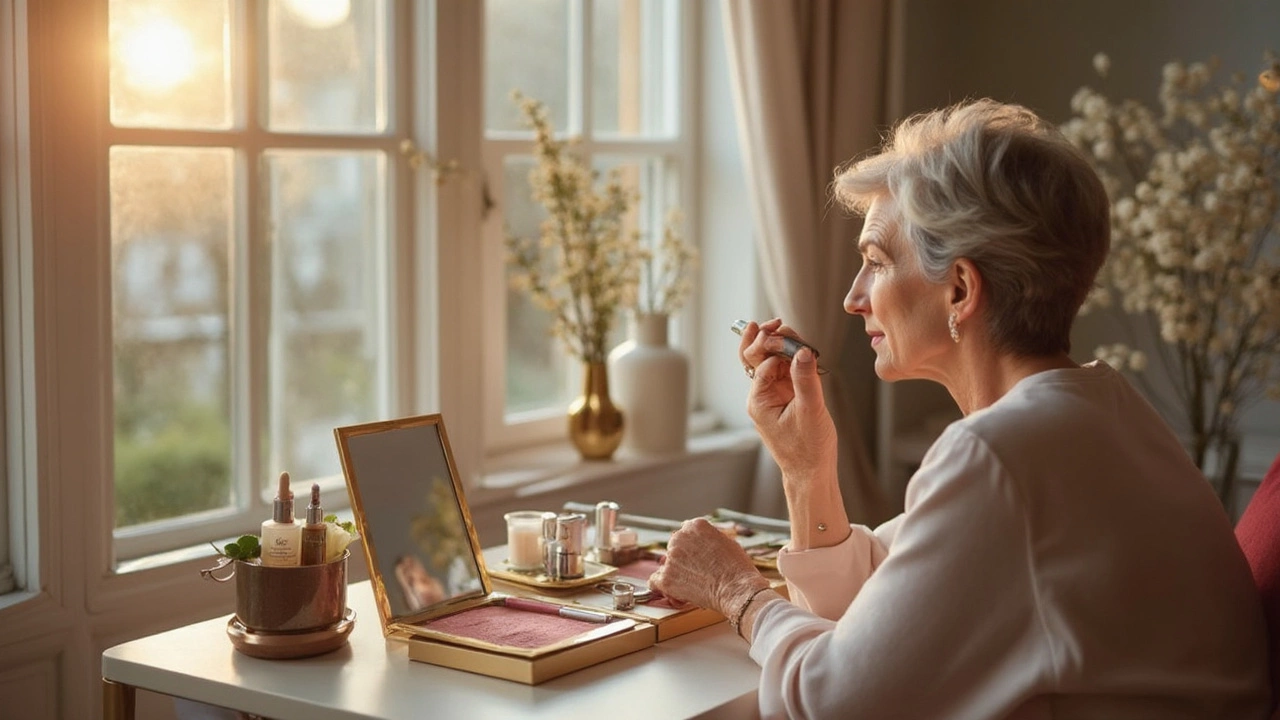Notice your makeup settling into lines, looking patchy, or feeling too heavy lately? You’re not imagining it—your skin is changing, and so should your makeup. Mature skin needs products and techniques that add bounce and glow, not more texture or dryness.
The good news? You don’t need to throw everything out and start over. It’s about swapping out a few old habits and picking creams, foundations, and powders that work with your skin, not against it. Creamy, hydrating formulas usually look more natural on mature skin than anything too matte or powdery. Ingredients like hyaluronic acid, peptides, and gentle antioxidants can boost both your skincare and your makeup routine at the same time.
As we get older, our skin loses moisture faster, which makes those classic full-coverage products look cakey. Instead, look for makeup that adds radiance and lets a bit of your own skin show through. It’s about looking like you—just a little more polished.
- Understanding Mature Skin
- Choosing the Right Foundation
- Concealers and Powders: What to Avoid (and Embrace)
- Eyes, Brows, and Lips: Age-Smart Picks
- Pro Tips for a Fresh, Radiant Look
Understanding Mature Skin
Mature skin changes in ways that really impact how makeup sits and looks. It’s not just about getting more wrinkles. Skin loses some collagen and elasticity, which means it can start to sag or look less firm. On top of that, hydration drops because your body makes less oil, so dry spots and flakiness become more common. And guess what? Cell turnover slows down too, so skin can look a bit duller unless you help it along.
Let’s take a look at what actually happens as skin matures:
- Fine lines and deeper wrinkles become more noticeable, especially around the eyes and mouth.
- Uneven pigmentation or age spots can pop up, fueled by years in the sun.
- Pores might look larger, or skin texture can feel rougher than before.
- Redness, broken capillaries, or blotchiness are a lot more common.
- Under-eye circles might look darker as skin thins out in that area.
It’s not all doom and gloom—just a sign that your makeup routine needs some tweaks. Hydration and gentle exfoliation (think creamy cleansers, not those gritty scrubs) are huge for keeping mature skin looking smooth. If you’re curious how widespread these changes are, check out these numbers:
| Age Group | % Experiencing Drier Skin | % Noticing More Fine Lines |
|---|---|---|
| 40-50 | 57% | 68% |
| 51-60 | 71% | 83% |
| 61+ | 81% | 90% |
Every skin type is different, but this gives you a sense of what’s happening under the surface—and why tweaking your makeup steps can pay off big. Next up, it’s all about finding the right foundation that doesn’t sit in every line or highlight dryness.
Choosing the Right Foundation
Picking the best foundation for mature skin can change your whole look, but most drugstore and high-end aisles feel impossible to navigate. Here’s the lowdown: as skin matures, it gets drier, thinner, and can sometimes look dull. That thick, matte foundation that looked great in your twenties? Now, it usually clings to lines and makes you look older. What you want is light to medium coverage, a creamy texture, and added hydration.
Ingredients matter. Foundations with hyaluronic acid, glycerin, and squalane keep skin moisturized through the day. Some products even sneak skincare into makeup—think vitamin C, peptides, or SPF. Avoid formulas labeled "long-wear matte" or "full coverage matte" unless your skin is oily. Matte products tend to exaggerate dry spots and wrinkles.
Application technique counts for a lot too. Heavy layers emphasize texture, so use a damp sponge or soft brush for a thin, even finish. Dot foundation on the cheeks, nose, forehead, and chin, then blend outward. You don’t need it everywhere—just enough to even out skin tone.
When it comes to color, choose shades with a neutral or slightly warm undertone to brighten your face. Too-pale foundation can look chalky; too-dark can settle into lines. And don’t forget to check in natural daylight before you commit to a shade.
- Look for "radiant," "luminous," or "hydrating" foundation formulas.
- Test texture on the back of your hand—it should glide without dragging.
- Swap to a lighter formula for summer and a richer, more moisturizing formula in winter.
Here’s one more tip: don’t skip prepping your skin. Using a light moisturizer and a silicone-free primer helps foundation sit smoothly. If your skin is super dry, let your moisturizer soak in for five minutes before foundation goes on.
| Foundation Type | Best For | Common Ingredients |
|---|---|---|
| Cream | Dry, mature skin | Hyaluronic Acid, Squalane, Peptides |
| Liquid (hydrating) | Normal to dry skin | Glycerin, Vitamin C, Ceramides |
| Powder | Oily skin only | Silica, Talc |
| Stick | Targeted coverage | Oils, Waxes |
So, go for comfort and glow, not just coverage. The right foundation can smooth things out, add life, and make the rest of your makeup routine a whole lot easier.

Concealers and Powders: What to Avoid (and Embrace)
If you’re using the same concealer you loved in your twenties, it’s probably not doing you any favors now. Thick, dry concealers settle right into fine lines, making them stand out more. The new rule: less is more, and creamy is better. Go for a lightweight liquid or cream concealer that blends out easily and adds a touch of brightness.
Here’s the trick—spot-conceal only where you need it. Under the eyes? Just a dot or two, patted gently with your ring finger or a soft sponge. For dark circles, pick a slightly peach-toned formula to counteract the blue undertones. For redness or brown spots, match your makeup shade closely, since anything too light looks chalky fast.
- Avoid: Super-dense concealers, sticks meant for blemishes, anything labeled “matte full-coverage.”
- Embrace: Sheer, creamy concealers, hydrating formulas, and pens with built-in brighteners.
Powder is another hard sell for mature skin. Traditional pressed powders soak up any leftover moisture, which is exactly what mature skin doesn’t need. Look for finely-milled, translucent powders if you must set your makeup. Or even better, skip powder except on the spots where you get shiny—like your T-zone. Don’t dust powder all over your face; it only highlights texture and makes everything look dull.
Check out this quick breakdown of common ingredients and how they impact mature skin:
| Ingredient | Effect on Mature Skin |
|---|---|
| Hyaluronic Acid | Adds hydration, smooths the look of fine lines |
| Talc | Can be drying, settles in lines |
| Dimethicone | Helps glide and fill out texture for a smoother finish |
| Glycerin | Boosts moisture, gives concealer flexibility |
Bottom line? The best concealers and powders for mature skin are light, hydrating, and barely-there. Go easy and let your natural skin shine through. Nothing brightens your look more than skipping the heavy stuff.
Eyes, Brows, and Lips: Age-Smart Picks
Small tweaks with your eye, brow, and lip products can take years off your look—and help you avoid makeup that settles into fine lines or looks dated. Here’s how to shop and apply smarter if you’re working with mature skin:
- Eyes: Swap dry, chalky powder shadows for creamy or satin-finish formulas. Cream shadows blend more easily and won’t cling to dryness on the lids. If you go for liner, try a soft pencil or gel instead of a harsh liquid—gentle definition looks fresher than a sharp line. Skip glitter (which can highlight every crease) and try a subtle shimmer instead.
- Brows: Thinning brows are super common with age. Go for a fine-tip pencil or tinted brow gel to fill in gaps and add definition without looking drawn-on. Aim for a shade that matches your natural brow color or is just a tad lighter; too dark can look harsh.
- Lips: Moisture is everything here. Grab a creamy lipstick or hydrating balm—matte formulas suck the life out of lips and can highlight lines. Lip liner is your friend, too. It helps stop lipstick from feathering, which happens more easily when you’ve got fine lines around your mouth. If you want your lips to look fuller, dab a little gloss on the center after applying your color.
| Area | Type to Try | Skip |
|---|---|---|
| Eyes | Cream shadow, gel pencil, tubing mascara | Dry powder, thick liquid liner, glitter |
| Brows | Fine-tip pencil, tinted gel, brow powder | Heavy pomade, overly dark color |
| Lips | Cream lipstick, tinted balm, hydrating liner | Matte lipstick, long-wear stains |
A study from a well-known dermatology group in 2023 found that 6 out of 10 women over 50 said creamy eye products made their eyes look less droopy and more awake than powder formulas. Another interesting fact: regular use of a clear brow gel with peptides can encourage healthier, fuller-looking brows fast.
The right makeup for these features is all about hydration, softer definition, and a touch of sheen—it makes skin look brighter and lets your features pop naturally. Little upgrades in your makeup bag can totally boost your confidence and comfort, with very little extra effort.

Pro Tips for a Fresh, Radiant Look
Getting that natural glow on mature skin is more about smart choices than piling on extra products. If you want your makeup to look fresh all day—and not slip into lines or dry patches—these tried-and-true tips really help. Here’s what works for real people, not just models in commercials.
- Makeup sits better on moisturized skin. Always prep with a lightweight, nourishing moisturizer. This helps foundation glide on and keeps everything looking smooth instead of bunching up in lines.
- Use a damp makeup sponge, not your fingers, to apply foundation and concealer. You'll get even coverage without streaks or cake. Sponges press product into the skin, which looks way more natural, especially if your skin is drier or less bouncy than before.
- Highlighter is your friend, but cream formulas beat powders here. Dab a tiny bit on your cheekbones and inner corners of your eyes for quick, believable brightness.
- Want to make your eyes pop? Try a soft brown liner instead of black. It’s less harsh and doesn’t draw attention to fine lines. Plus, stick to creamy or satin-finish eyeshadows—the old matte and glitter shadows can make lids look older.
- Toss those dry, matte lipsticks. Go for hydrating lip balms, tinted oils, or creamy formulas. Your lips will look fuller, and you’ll skip that cracked feeling by lunchtime.
Ever notice how makeup can disappear fast as the day goes on? Mature skin produces less oil, so products don’t stick around as long. That’s why touch-ups help: keep a mini hydrating mist or balm in your purse for a mid-day refresh.
If you’re into stats, check this out: In a 2024 survey of 1,000 women ages 50 and up, 68% said switching from powder to cream-based products made their skin look more luminous. And here’s a quick cheat sheet for go-to makeup upgrades:
| Replace This | With This |
|---|---|
| Heavy matte foundation | Lightweight hydrating foundation |
| Powder blush | Cream blush |
| Powder highlighter | Cream highlighter |
| Black eyeliner | Brown or navy eyeliner |
| Matte lipstick | Moisturizing lipstick or balm |
The bottom line? Less is more. Focus on skincare, choose creamy products, and keep the routine simple. That’s how you get that easy, healthy radiance—no filters needed.
